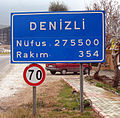This article needs additional citations for verification .(November 2016) |
A town sign or city limit sign is a road sign placed at the side of the road or street at the boundary of the territory of a city, town, or village. Town signs may be placed for reading both by drivers entering the town and, in a different format, by those exiting it. Signs give the name of the town in the local official languages, and sometimes in other languages. In some countries, town signs are also an essential part of the traffic law, for example by defining (explicitly or implicitly) the speed limit within the town's territory.






















